

Throughout the annals of history, there are countless mysteries that have intrigued and baffled us. From ancient unsolved enigmas to modern-day puzzles, these mysteries have shaped the course of history and continue to fascinate people around the world. Their allure lies not only in the questions they pose but also in the profound impact they have had on humanity’s quest for knowledge and understanding. We often find ourselves drawn to these mysteries, seeking answers that may forever elude us, yet their existence compels us to explore the boundless possibilities of what we may discover.
In this article, we delve into 10 of the most compelling mysteries unsolved by anyone, to this day. We will explore the enigmatic Lost Colony of Roanoke, the perplexing Voynich Manuscript, and the bewildering Dancing Plague of 1518, among others. Each of these chapters uncovers a unique tale that challenges our understanding and invites us to question the established narrative. From the unexplainable to the seemingly supernatural, these mysteries continue to intrigue us, offering a glimpse into the unknown realms of our past, and perhaps, our future.
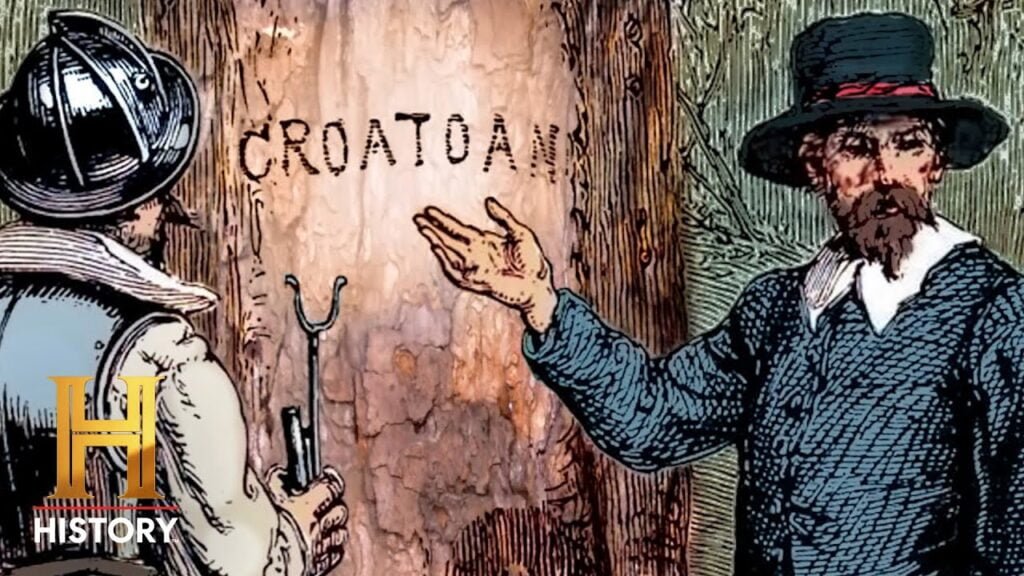
The origins of one of America’s oldest unsolved mysteries trace back to August 1587, when about 115 English settlers arrived on Roanoke Island, off the coast of what is now North Carolina. Their mission was to establish the first permanent English outpost in the New World, but by 1590, when Governor John White returned from a supply trip from England, he found the colony deserted, with no trace of the inhabitants except for the cryptic word “Croatoan” carved into a post.
This disappearance has puzzled historians and archaeologists for centuries. The settlers, including White’s own family and Virginia Dare, the first English child born in the Americas, vanished without leaving any clear evidence of their fate. The absence of a Maltese cross, which would indicate a forced departure, suggests they left voluntarily, but the reasons and their subsequent fate remain shrouded in mystery.
Over the years, numerous theories have been proposed about what happened to the lost colonists. Some suggest they were killed or abducted by Native Americans or Spanish forces from nearby Florida. Others believe they tried to return to England and were lost at sea. The most widely accepted theory is that they assimilated with local Native American tribes, possibly the Croatoans on Hatteras Island, as indicated by the word carved on the post. Reports from the Jamestown colonists and sightings of Europeans among Native Americans in later years support this theory, though conclusive evidence has never been found.
Modern efforts to solve this mystery have included archaeological digs and DNA testing of local populations to find links to the Roanoke settlers. Excavations at sites like Site X in Bertie County, North Carolina, have uncovered English artifacts from the 16th century, suggesting the presence of Europeans. Although these findings provide tantalizing clues, they have yet to definitively explain the fate of the Roanoke colonists. The mystery of what happened to these early settlers continues to captivate the imagination, serving as a reminder of the challenges and uncertainties that faced the first English attempts to settle in the New World.
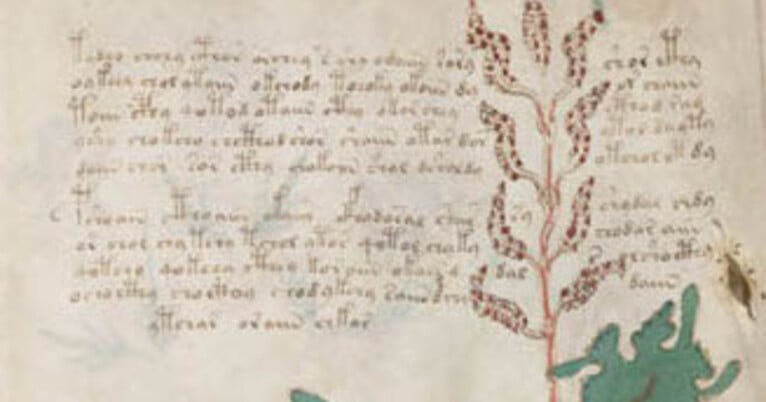
The Voynich Manuscript is a fascinating artifact, written in an unknown script on vellum dated between 1404 and 1438. Believed to have originated during the Italian Renaissance, the manuscript remains one of history’s most intriguing puzzles due to its mysterious content and the unknown identity of its author.
The manuscript’s journey began in Central Europe, possibly at the end of the 15th or during the 16th century. It was named after Wilfrid M. Voynich, a Polish-American antiquarian bookseller who acquired it in 1912. The codex changed hands several times, with notable owners including Emperor Rudolf II, who believed it to be the work of Roger Bacon, and the Jesuit College at Frascati near Rome, where it remained until Voynich discovered it.
Deciphering the Voynich Manuscript has been a challenge for both amateur and professional cryptographers, including notable figures like American and British codebreakers from both World Wars. Despite their efforts, the manuscript has never been demonstrably deciphered, and no proposed hypotheses about its content have been verified. Modern computational linguistics have also tried to unravel its secrets, providing insights but no conclusive breakthroughs.
Theories about the manuscript’s purpose are as varied as its content, which includes botanical, astronomical, and biological sections, among others. Some speculate it might be a compendium of medieval herbal medicine, an alchemical text, or even connected to religious, occult, or esoteric practices. The manuscript’s intricate illustrations and undeciphered text continue to fuel speculation and study, making it a perennial subject of fascination in the world of historical mysteries.
This enigmatic manuscript, with its blend of artistic beauty and cryptic language, invites us to ponder the limits of historical knowledge and the mysteries that remain unsolved.

In July 1518, the streets of Strasbourg witnessed an extraordinary event known as the Dancing Plague. It began when Frau Troffea stepped outside her home and started dancing fervently. Within days, her solitary performance escalated as dozens joined her, culminating in a crowd of about 400 people, dancing uncontrollably through the streets. This bizarre spectacle continued for weeks, with some participants dancing to their deaths from exhaustion or acute medical episodes like strokes and heart attacks.
The phenomenon started with Frau Troffea and rapidly spread, affecting hundreds. The local authorities, perplexed and desperate to control the situation, even facilitated the event by providing a stage and hiring musicians, hoping to end the crisis. However, this only intensified the mania. The episode stretched from July to early September, finally concluding when the remaining dancers were taken to a mountain shrine to seek divine intervention.
Historians and scientists have proposed several theories over the centuries. Some suggest mass psychogenic illness, a collective psychological disorder prompted by extreme stress and superstition. Others believe ergot poisoning might be to blame, as it causes hallucinations and convulsions, mirroring the symptoms observed in the dancers. A popular historical belief was that these were acts of divine wrath or demonic possession, typical of the period’s understanding of inexplicable social phenomena.
The Dancing Plague of 1518 remains a compelling story of human behavior and mass hysteria. It serves as a historical example of how psychological and physiological factors can combine under certain stresses—like famine and disease—to trigger extraordinary public responses. This event has not only inspired numerous academic studies but also infiltrated popular culture, reflecting its lasting fascination. The incident underscores the complex interplay between health, belief, and environment, highlighting how communal beliefs and psychological states can trigger dramatic reactions.
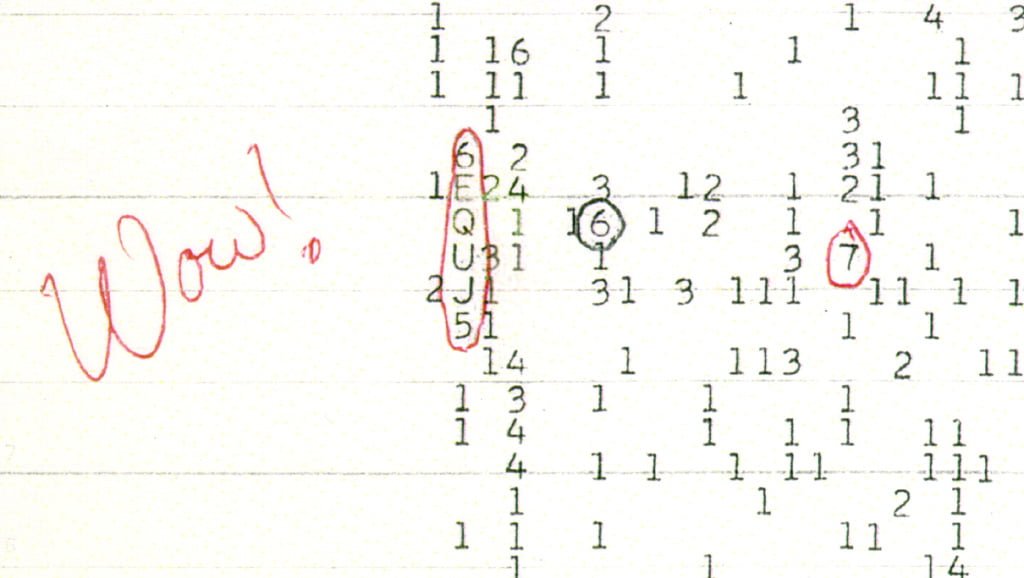
On August 15, 1977, a strong narrowband radio signal was detected by the Big Ear radio telescope at Ohio State University, an event that would later be named the “Wow! Signal” due to the astonishment it caused. This signal, distinguished by its intensity and duration, was unique because it appeared to come from the direction of the constellation Sagittarius and bore the hallmarks of what might be considered an extraterrestrial origin.
The Wow! Signal was discovered by astronomer Jerry R. Ehman, who was analyzing data by hand from the telescope’s printouts. He noticed an unusual sequence marked by “6EQUJ5,” which indicated a strong signal that lasted for a full 72-second window—just long enough for the telescope, following the Earth’s rotation, to observe it. Struck by the anomaly, Ehman circled the sequence and excitedly wrote “Wow!” beside it.
The Wow! Signal remains one of the most tantalizing pieces of evidence potentially pointing to extraterrestrial intelligence, primarily because it was a strong, clear signal that did not match any known celestial or terrestrial source. Its characteristics were exactly what SETI, the Search for Extraterrestrial Intelligence, was designed to find, making it a significant yet puzzling discovery in the field of astronomy.
Despite numerous attempts to detect the signal again, it has never been replicated. Theories about its origin range from interstellar scintillation—a phenomenon akin to the twinkling of stars due to atmospheric interference—to more controversial suggestions like reflections off space debris or emissions from a passing comet. However, none of these theories have been universally accepted, leaving the Wow! Signal as one of the enduring mysteries in the search for extraterrestrial life.
The lack of a repeat occurrence has only deepened the mystery, prompting continued debate and study among scientists and enthusiasts alike. Whether it was a fleeting interception of an alien broadcast or merely an anomalous celestial event, the Wow! Signal invites us to keep looking up and questioning what might be out there.
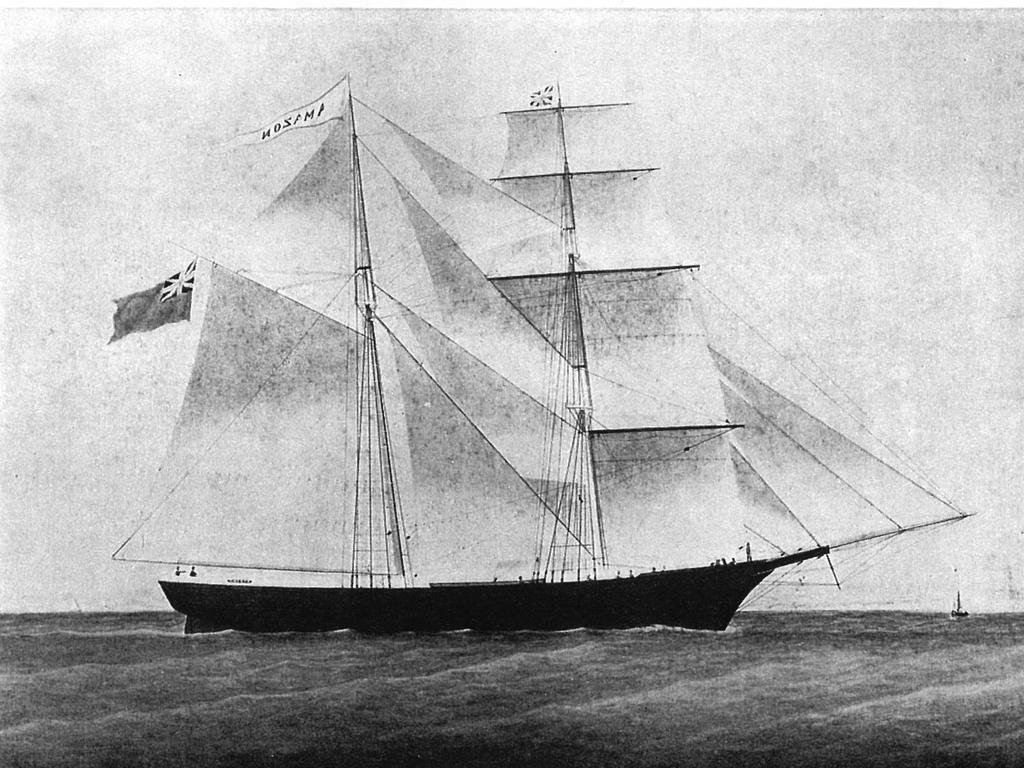
On November 7, 1872, the Mary Celeste set sail from New York City to Genoa, Italy, with a cargo of 1,701 barrels of industrial alcohol. Captain Benjamin Spooner Briggs, his family, and a crew of seven were aboard. Despite the ship being in seaworthy condition and well-provisioned for a long journey, something mysterious occurred. By December 4, the ship was found adrift near the Azores Islands by the British brig Dei Gratia, completely abandoned yet undamaged, with the crew’s personal belongings undisturbed.
Several theories have been proposed to explain the abandonment of the Mary Celeste. One prevalent theory suggests that the crew might have feared an explosion due to fumes from leaking alcohol barrels, evidenced by nine empty barrels found on board. Another theory points to a malfunctioning pump and a faulty chronometer, leading Captain Briggs to believe the ship was taking on more water than it was, prompting him to order an abandonment close to the shore. Additionally, theories of mutiny, piracy, and insurance fraud have circulated, but none have conclusively explained the crew’s disappearance.
The mystery of the Mary Celeste has significantly impacted maritime lore, symbolizing the ultimate ghost ship narrative. It has inspired numerous books, documentaries, and films, each exploring the various theories and adding to the mystique surrounding the event. The ship’s story remains a captivating mystery, emblematic of the sea’s enigmatic nature and mankind’s attempt to understand the unexplainable. The Mary Celeste continues to intrigue and inspire, a testament to the enduring allure of maritime mysteries.

On the morning of June 30, 1908, the skies above a remote part of Siberia were illuminated by a blinding flash, followed by a massive explosion that resonated across the region. The event, now known as the Tunguska explosion, occurred near the Podkamennaya Tunguska River and released energy equivalent to 10-15 megatons of TNT. This explosion flattened approximately 2,000 square kilometers of forest and caused significant atmospheric effects observed as far away as Europe.
The first scientific expedition to investigate the Tunguska site was led by Soviet scientist Leonid Kulik in the 1920s. Kulik and his team found a vast area of fallen trees spread radially from a central point, which suggested a massive explosion from above rather than an impact on the ground. Subsequent investigations throughout the 20th century collected samples from the site, which revealed microscopic particles that hinted at an extraterrestrial origin. The most conclusive evidence came from a 2013 analysis that found high levels of materials common to rocky asteroids in the resin of trees from the impact area.
The cause of the Tunguska event has been a topic of debate among scientists. Initially, it was believed to be caused by a comet, as suggested by the British astronomer F.J.W. Whipple in 1930, because of the glowing skies reported after the blast, indicative of dust and ice in the upper atmosphere. However, more recent studies and simulations suggest that a small asteroid, possibly up to 200 meters in diameter, was the culprit. This asteroid likely disintegrated due to high heat and pressure before reaching the ground, explaining the lack of an impact crater. This theory is supported by data modeling the passage of asteroids through Earth’s atmosphere, showing that an iron asteroid of this size could vaporize if it entered at a shallow angle.
The Tunguska event remains one of the most powerful expressions of our planet’s dynamic interactions with celestial objects and continues to be a subject of fascination and study in the scientific community.

The Hanging Gardens of Babylon, often celebrated as one of the Seven Wonders of the Ancient World, have been shrouded in mystery due to their elusive historical footprint. Ancient texts, primarily from Greek and Roman sources, describe these gardens as an astonishing feat of engineering, attributed to Nebuchadnezzar II who supposedly built them to comfort his homesick wife, Amytis. These texts portray the gardens as a lush paradise, cascading with vegetation over structured terraces, employing an advanced irrigation system to sustain its vibrant flora.
Despite their fame, the actual existence of the Hanging Gardens remains a topic of intense debate among historians and archaeologists. Systematic excavations initiated in the late 19th century have yet to uncover concrete evidence of the gardens at the traditionally accepted location in Babylon. Some findings, such as vaulted rooms and large drains near the Euphrates, hint at sophisticated irrigation but do not confirm the presence of the gardens. This absence of definitive archaeological evidence has fueled alternative theories about their location and existence.
The mystery deepens with suggestions that the Hanging Gardens might not have been located in Babylon after all. Research by scholars like Stephanie Dalley proposes that the gardens were actually in Nineveh, built by the Assyrian king Sennacherib rather than Nebuchadnezzar. This theory is supported by descriptions of an extensive aqueduct system in Assyrian texts, which aligns with the engineering required to sustain such gardens. However, the lack of conclusive proof and the reliance on historical interpretations keep the true story of the Hanging Gardens tantalizingly out of reach, continuing to spark both scholarly research and popular imagination.
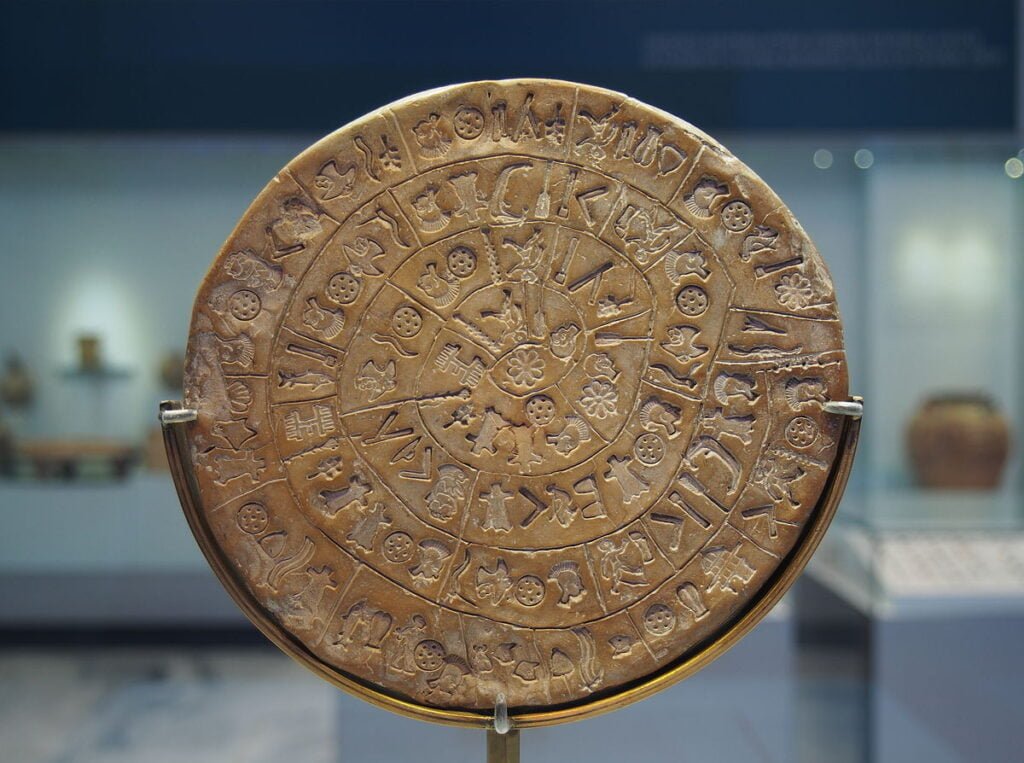
Discovered in 1908 by Luigi Pernier in the Minoan palace of Phaistos on the island of Crete, the Phaistos Disc remains an enigma wrapped in clay. This unique artifact, approximately 15 centimeters in diameter, stands out for its spiral arrangement of 242 stamped symbols, which no one has yet managed to fully decipher.
The disc was unearthed in a small underground “temple depository,” a room used for storage within the palace complex. Found alongside burnt bovine bones and Linear A tablets, the disc’s discovery context suggests it was considered significant by its creators, preserved meticulously under a layer of fine plaster.
Over the years, countless scholars and cryptographers have grappled with the disc’s symbols, proposing interpretations ranging from hymns to complex narratives. The script, possibly a mix of syllabic and logographic elements, resembles no other, complicating efforts to unlock its secrets. Without more examples of these symbols, the true meaning of the Phaistos Disc may remain locked away, as current theories rely heavily on speculative connections to known scripts like Linear A and B.
Theories about the disc’s purpose are as varied as the symbols on its surface. Some suggest it was a religious or ceremonial object, perhaps a detailed account of a ritual or a calendar. Others speculate it could have been a game or even an early example of printed text, given its method of production involving stamped symbols. Despite extensive studies, the disc’s true function and the message it bears continue to elude definitive explanation, maintaining its status as one of the most tantalizing mysteries in archaeology.

The Copper Scroll, discovered in 1952 near Qumran, stands out among the Dead Sea Scrolls due to its unique content and form. Unlike the other scrolls, which are primarily religious or literary, the Copper Scroll lists 64 locations hiding vast treasures. The inventory includes enormous quantities of gold and silver, estimated in the tons, such as 900 talents (approximately 868,000 troy ounces) of gold buried alone. The scroll also mentions tithing vessels, priestly vestments, and other sacred items, suggesting a connection to the Temple in Jerusalem.
Despite extensive efforts by archaeologists and treasure hunters, the treasures listed in the Copper Scroll have eluded discovery. The descriptions in the scroll are cryptic and lack specific geographical details, making the locations difficult to pinpoint. Some experts believe the treasures may have been moved or already looted in ancient times. Others hold onto hope that a breakthrough in deciphering the text could someday lead to a significant find.
Scholars are divided on the origin and purpose of the Copper Scroll. Some suggest it details the hidden wealth of a Jewish sect, possibly the Essenes, during the turbulent times of the Jewish-Roman wars. Others propose it served as a temple inventory, hidden to protect valuable items from Roman forces. Theories also explore the possibility of the scroll being a symbolic or mythological text rather than a literal treasure map. The debate continues, with the scroll’s exact implications and origins remaining one of the great archaeological mysteries.

The Ark of the Covenant, a central artifact in biblical history, symbolizes God’s presence and has been pivotal in numerous biblical narratives. Its journey is well documented up to its last mention in the scriptures during King Josiah’s reign, who placed it in Solomon’s Temple. However, its fate becomes ambiguous post the Babylonian invasion led by Nebuchadnezzar in 586 BC, where the temple was destroyed and the Ark was not listed among the spoils or the items returned by Cyrus, the king of Persia.
The Ark’s significance is repeatedly affirmed in the scriptures. It was last noted in the Second Book of Chronicles, where King Josiah commands the Levites to house the Ark in Solomon’s Temple. This moment marks the last known location of the Ark before the subsequent destruction of Jerusalem and the temple.
The disappearance of the Ark has spawned numerous theories and legends. One prevailing theory suggests King Josiah hid the Ark to protect it from the Babylonian invasion. Locations proposed for its concealment include a cave near the Dead Sea and a secret chamber under the Temple Mount. Another intriguing theory involves the Ark being taken to Ethiopia, as claimed by the Ethiopian Orthodox Church, which alleges that the Ark resides within the Church of Saint Mary of Zion, guarded by a designated monk.
Modern efforts to locate the Ark have been met with various challenges, particularly due to the sensitive nature of potential dig sites. The Temple Mount, a site of profound religious importance and conflict, is a primary location of interest. However, political and religious sensitivities make archaeological explorations there nearly impossible. Despite these challenges, the search for the Ark continues to captivate the imagination of historians, archaeologists, and the faithful, symbolizing a quest not just for a biblical relic, but for an understanding of ancient divine phenomena.
Through this exploration of the world’s most perplexing unsolved mysteries, from ancient enigmas like the fate of the Lost Colony of Roanoke and the bewildering design of the Voynich Manuscript to modern puzzles such as the Wow! Signal, we venture into the vast expanses of human knowledge and its limits. Each story, whether it’s the mesmerizing account of the Mary Celeste or the speculative theories surrounding the Tunguska Event, not only captivates our imagination but also challenges our understanding of history, the universe, and our place within it. By delving into these mysteries, we are reminded of the enduring human desire to explore the unknown and the complexities that arise when the answers elude us.
The significance of these unsolved mysteries extends beyond their immediate intrigue, serving as beacons that draw us toward the unrelenting pursuit of knowledge. They encourage not only the questioning of accepted narratives but also the exploration of new ideas and perspectives. As we contemplate these enduring mysteries, we find ourselves at the intersection of history, science, and mythology, invited to ponder the countless possibilities that await discovery. In the end, the quest for answers continues to fuel our collective imagination and underscores the vastness of the tapestry of human experience.
By using hiddenpapers.com you agree to our Privacy Policy terms.